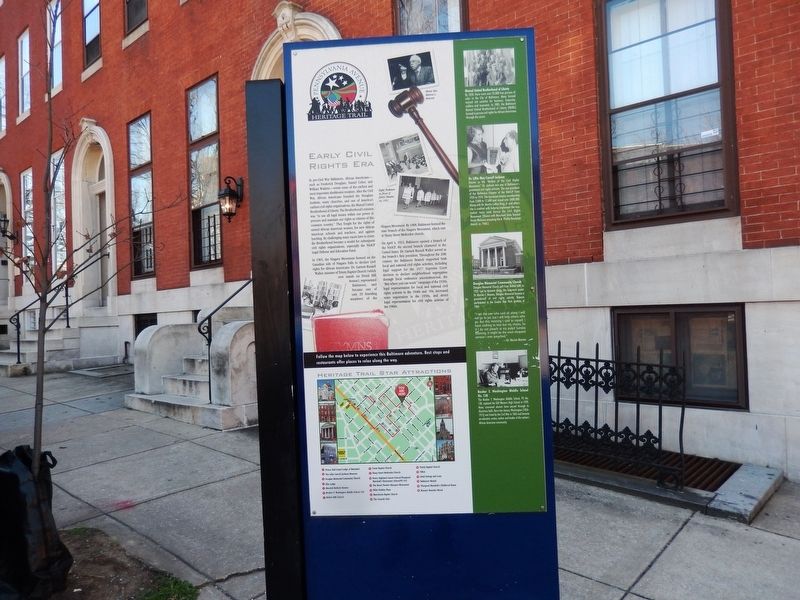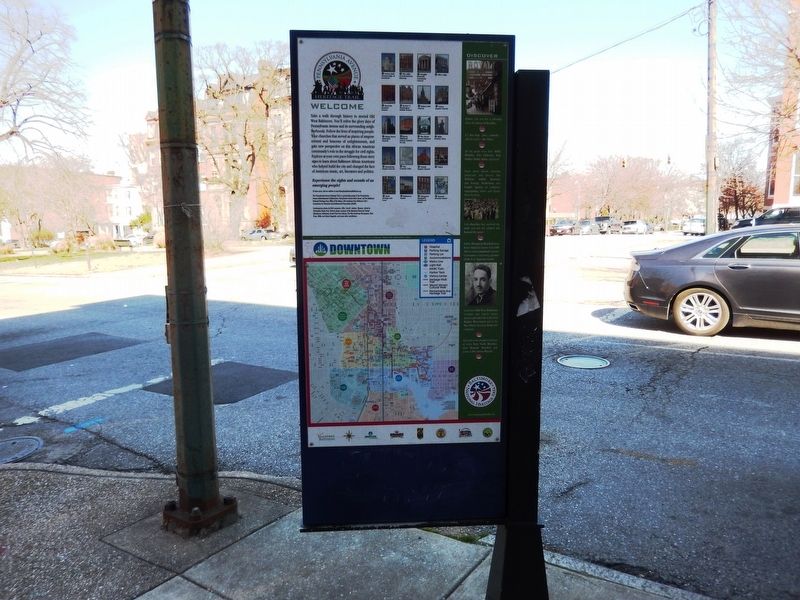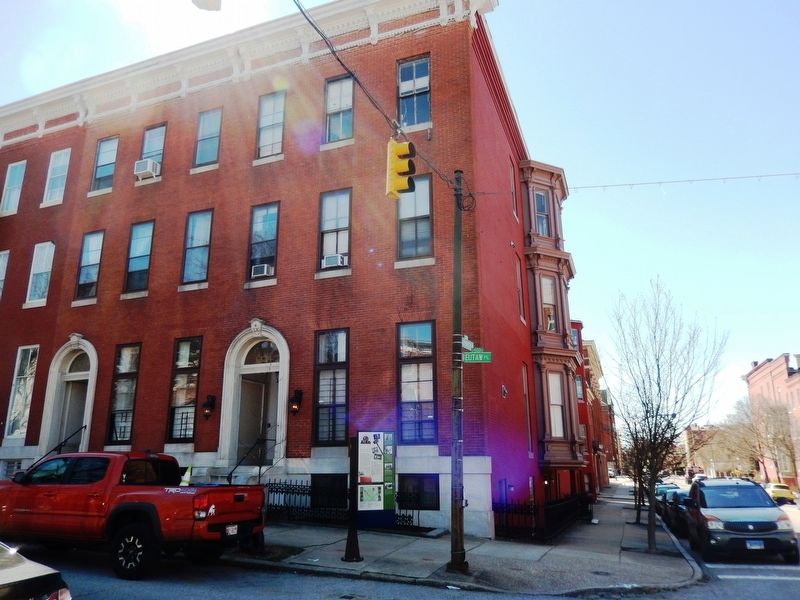Madison Park in Baltimore, Maryland — The American Northeast (Mid-Atlantic)
Early Civil Rights Era
Pennsylvania Avenue Heritage Trail
In pre-Civil War Baltimore, African Americans — such as Frederick Douglass, Daniel Coker, and William Watkins — wrote some of the earliest and most important abolitionist treatises. After the Civil War, African Americans founded the Douglass Institute, many churches, and one of America’s earliest civil rights organizations, the Mutual United Brotherhood of Liberty. The Brotherhood’s mission was “to use all legal means within our power to procure and maintain our rights as citizens of this common country.” They fought for the rights of unwed African American women, for new African American schools and teachers, and against lynching. By challenging many racist laws in court, the Brotherhood became a model for subsequent civil rights organizations, especially the NAACP Legal Defense and Education Fund.
In 1905, the Niagara Movement formed on the Canadian side of Niagara Falls to declare civil rights for African Americans. Dr. Garnett Russell Waller, minister of Trinity Baptist Church (which now stands on Druid Hill Avenue), represented Baltimore, and became one of only 29 founding members of the Niagara Movement. By 1908, Baltimore formed the state branch of the Niagara Movement, which met at Sharp Street Methodist Church.
On April 4, 1912, Baltimore opened a branch of the NAACP, the second branch chartered in the United States. Dr. Garnett Russell Waller served as the branch’s first president. Throughout the 20th century, the Baltimore Branch supported both local and national civil rights activities, including legal support for the 1917 Supreme Court decision to declare neighborhood segregation through local ordinance unconstitutional, the “Buy where you can work” campaign of the 1930s, legal representation for local and national civil rights activists in the 1940s and ‘50s, increased voter registration in the 1950s, and direct legal representation for civil rights activists of the 1960s.
(Inscription beside the image in the upper center)
Right: Picketers in front of Ford’s Theatre, ca. 1951.
(Inscription under the images on the right)
Mutual United Brotherhood of Liberty
By 1850, there were over 25,000 free persons of color in the City of Baltimore. Many formed mutual aid societies for business, fraternity, welfare and insurance. In 1885, the Baltimore Mutual United Brotherhood of Liberty (MUBL) formed to pursue civil rights for African Americans through the courts.
Dr. Lillie May Carroll Jackson
Known as the “Mother of the Civil Rights Movement,” Dr. Jackson was one of Baltimore’s prominent civil rights activists. She was president of the Baltimore Chapter of the NAACP from 1935 to 1970. She increased chapter membership from 2,000 to 17,600 and raised over $400,000. Along with Dr. Martin Luther King Jr. and others, she is credited with helping implement the non-violent tactic used during the Civil Rights Movement. (Shown with Maryland State Senator Verda Welcome accepting the A. Phillip Randolph Award, ca. 1968.)
Douglas Memorial Community Church
Douglas Memorial Church split from Bethel AME in 1925. Led by dynamic clergy, like long-term pastor Dr. Marion C. Bascom, Douglas Memorial became a groundswell of civil rights activity. Bascom participated in the Gwynn Oak Park protests of 1964.
“I am the one who said all along I will not go to jail, but I will help others who go. But this morning I said to myself I have nothing to lose but my chains. So if I do not preach at my pulpit Sunday morning, it might be the most eloquent sermon I ever preached.”
–Dr. Marion Bascom.
Reverse Side of the Marker
Welcome
Take a walk through history in storied Old West Baltimore. You’ll relive the glory days of Pennsylvania Avenue and its surrounding neighborhoods. Follow the lives of inspiring people. Tour churches that served as places of empowerment and beacons of enlightenment, and gain new perspective on this African American community’s role in the struggle for civil rights. Explore at your own pace following these story signs to learn about Baltimore African Americans who helped build a city and changed the face of American music, art, literature and politics.
(Inscriptions under the images on the right)
1.Prince Hall Grand Lodge of Maryland
2.The Lillie Carroll Jackson Museum
3.Douglas Memorial Community Church
4.Elks Lodge
5.Morriah Keyhole Houses
6.Booker T. Washington Middle School
7.Bethel AME Church
8.Union Baptist Church
9.Sharp Street Methodist Church
10.Henry Highland Garnet School/PS 103
11.The Royal Theatre Marquee Monument
12.Billie Holiday Plaza
13.Macedonia Baptist Church
14.The Comedy Club
15.Trinity Baptist Church
16.YMCA
17.Ideal Savings and Loan
18.Baltimore Masjid
19.Thurgood Marshall’s Childhood Home
20.Romare Bearden Mural.
Discover
(Inscriptions under the images)
*Listen, Can you feel it pulsating down the Street of Royalty?
*It’s bee-bop, jazz, comedy—and of course—the blues.
*All the greats were here. Billie Holiday, Cab Calloway, Fats Waller, Eubie Blake and more!
*Learn about African American politicians and lawyers like William Ashbie Hawkins and George McMechan who fought against an ordinance segregating whites and blacks block by block.
*Visit churches that nurtured the soul, and also fed, clothed and housed the poor.
*Follow Thurgood Marshall from Henry Highland Garnet School/PS 103, to winning landmark Supreme Court cases, to becoming a justice of the U.S. Supreme Court.
*Learn how Old West Baltimore residents and church leaders played a pivotal role in the Civil Rights Movement and in the Buy Where You Can Work jobs campaign.
*And walk in the creative footsteps of writer Zora Neale Hurston, artist Romare Bearden and actors at the Arena Players.
Topics and series. This historical marker is listed in these topic lists: African Americans • Churches & Religion • Civil Rights. In addition, it is included in the African Methodist Episcopal (AME) Church series list. A significant historical date for this entry is April 4, 1912.
Location. 39° 18.271′ N, 76° 37.624′ W. Marker is in Baltimore, Maryland. It is in Madison Park. Marker is at the intersection of Eutaw Place and West Lafayette Avenue on Eutaw Place. Touch for map. Marker is at or near this postal address: 1324 Eutaw Pl, Baltimore MD 21217, United States of America. Touch for directions.
Other nearby markers. At least 8 other markers are within walking distance of this marker. Lillie Carroll Jackson Civil Rights Museum (a few steps from this marker); St. James Court (within shouting distance of this marker); Sidney Lanier (within shouting distance of this marker); Howard A. Kelly, M.D. (within shouting distance of this marker); Florence Hochschild Austrian / Robert Austrian (about 300 feet away, measured in a direct line); Daniel Coit Gilman (about 300 feet away); The Md. Prince Hall Masons (about 400 feet away); Francis Scott Key (about 400 feet away). Touch for a list and map of all markers in Baltimore.
Regarding Early Civil Rights Era. "McMechan" found, apparently should have been "McMechen".
Credits. This page was last revised on March 17, 2021. It was originally submitted on March 20, 2017, by Don Morfe of Baltimore, Maryland. This page has been viewed 370 times since then and 34 times this year. Last updated on March 16, 2021, by Carl Gordon Moore Jr. of North East, Maryland. Photos: 1, 2, 3. submitted on March 20, 2017, by Don Morfe of Baltimore, Maryland. • Bill Pfingsten was the editor who published this page.


